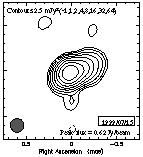
III Zw 2: superluminal expansion and compact lobe expansion in a Seyfert galaxy
Andreas Brunthaler 1 Heino Falcke1, Geoffrey C. Bower1,2, Margo F. Aller3, Hugh D. Aller3, Harri Teräsranta4,
1Max-Planck-Institut für Radioastronomie, Auf den Hüugel 69, D-53121 Bonn, Germany (hfalcke@mpifr-bonn.mpg.de)2Current address: NRAO, P.O. Box O, Socorro, NM 87801-0387
3Astronomy Department, University of Michigan, Ann Arbor, MI 48109-1090
4Metsähovi Radio Research Station, Metsahovintie, SF-02540 Kylmäalä, Finland 5Current Address: Harvard-Smithsonian Center for Astrophysics
in: Proceedings of the 5th European VLBI Network Symposium, held at Chalmers Technical University, June 29th - July 1st, 2000, Eds. J.E. Conway, A.G. Polatidis, R.S. Booth and Y.M. Philström, Onsala Space Observatory Publication, ISBN 91-631-0548-9, p. 11
Abstract:
So far, all relativistically boosted jets with superluminal motion have only been detected in typical radio galaxies with early type host galaxies. We have now discovered superluminal motion in the Seyfert I galaxy III Zw 2, classified as a spiral. The lower limit for the apparent expansion speed is 1.25 c. Spectral and spatial evolution are closely linked. Before and after this rapid expansion we have seen a period of virtually no expansion with an expansion speed less than 0.04 c. However, at 15 GHz the picture is completely different. III Zw 2 shows slow expansion ($\sim 0.6 c$) during the time of no expansion at 43 GHz and no expansion during the rapid expansion at 43 GHz. The difference between the two frequencies is qualitatively explained by optical-depth effects in an 'inflating- balloon model', describing the evolution of radio lobes on an ultra-compact scale. The stop-and-go behavior could be explained by a jet interacting with a molecular cloud or the molecular torus. Since III Zw 2 is also part of a sample of so- called radio-intermediate quasars (RIQ), it confirms earlier predictions of superluminal motion for this source, based on the argument that RIQs could be relativistically boosted jets in radio-weak quasars and Seyfert galaxies.
Paper: Available in PostScript and (AAS)LaTex. Please send an email request to hfalcke@mpifr-bonn.mpg.de for a preprint.
Other publications can be found here.
Questions: Heino Falcke, hfalcke@mpifr-bonn.mpg.de